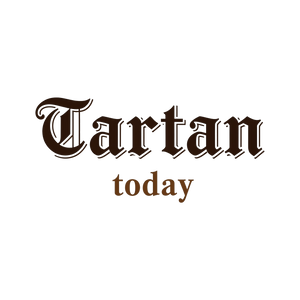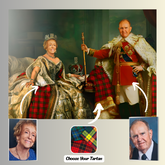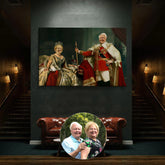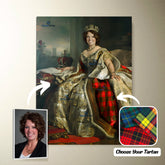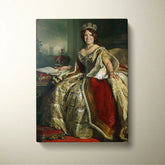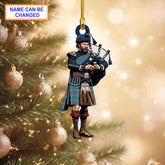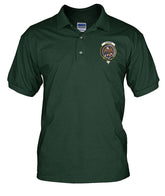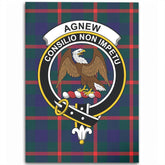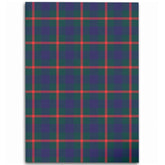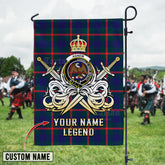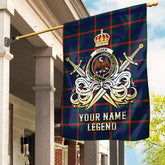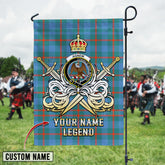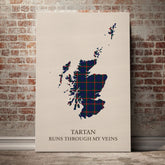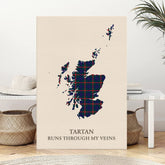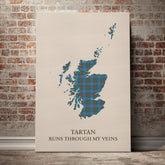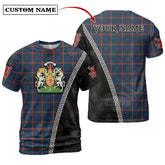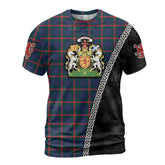-
Personalized Clan Agnew Ancient Tartan Bagpipe Ornament with Custom Name – Scottish Christmas Tree Decoration GG51
Personalized Clan Agnew Ancient Tartan Bagpipe Ornament with Custom Name – Scottish Christmas Tree Decoration GG51Celebrate your Scottish heritage with this unique wood & acrylic tartan ornament. Perfect as a personalized Christmas decoration or a meaningful gift for friends and relatives on special occasions...- From $19.99 USD
$25.99 USD- From $19.99 USD
- Unit price
- per
Save $6.00 -
Clan Agnew Family Crest Polo T-Shirt XX49
Clan Agnew Family Crest Polo T-Shirt XX49 Product Detail: KEY FEATURES:- Preshrunk 100% cotton jersey- 6 oz- Welt collar and cuffs- 3 wood tone buttons- Double needle bottom hem CARE INSTRUCTIONS:Machine wash warm, inside out, with like colors. Only non chlorine bleach. Tumble dry...- $38.25 USD
- $38.25 USD
- Unit price
- per
-
Personalized Clan Agnew Modern Tartan Drummer Ornament with Custom Name – Scottish Christmas Tree Decoration HN34
Personalized Clan Agnew Modern Tartan Drummer Ornament with Custom Name – Scottish Christmas Tree Decoration HN34Celebrate your Scottish heritage with this unique wood & acrylic tartan ornament. Perfect as a personalized Christmas decoration or a meaningful gift for friends and relatives on special occasions...- From $19.99 USD
$25.99 USD- From $19.99 USD
- Unit price
- per
Save $6.00 -
Personalized Clan Agnew Ancient Tartan Drummer Ornament with Custom Name – Scottish Christmas Tree Decoration IR26
Personalized Clan Agnew Ancient Tartan Drummer Ornament with Custom Name – Scottish Christmas Tree Decoration IR26Celebrate your Scottish heritage with this unique wood & acrylic tartan ornament. Perfect as a personalized Christmas decoration or a meaningful gift for friends and relatives on special occasions...- From $19.99 USD
$25.99 USD- From $19.99 USD
- Unit price
- per
Save $6.00 -
Personalized Clan Agnew Reproduction Tartan Bagpipe Ornament with Custom Name – Scottish Christmas Tree Decoration YN68
Personalized Clan Agnew Reproduction Tartan Bagpipe Ornament with Custom Name – Scottish Christmas Tree Decoration YN68Celebrate your Scottish heritage with this unique wood & acrylic tartan ornament. Perfect as a personalized Christmas decoration or a meaningful gift for friends and relatives on special occasions...- From $19.99 USD
$25.99 USD- From $19.99 USD
- Unit price
- per
Save $6.00 -
Personalized Clan Agnew Modern Tartan Bagpipe Ornament with Custom Name – Scottish Christmas Tree Decoration KM21
Personalized Clan Agnew Modern Tartan Bagpipe Ornament with Custom Name – Scottish Christmas Tree Decoration KM21Celebrate your Scottish heritage with this unique wood & acrylic tartan ornament. Perfect as a personalized Christmas decoration or a meaningful gift for friends and relatives on special occasions...- From $19.99 USD
$25.99 USD- From $19.99 USD
- Unit price
- per
Save $6.00 -
Personalized Clan Agnew (MacAgnew) Weathered Clan Crest Tartan Santa Ornament – Custom Acrylic Christmas Decoration NA30 - Agnew
Personalized Clan Agnew (MacAgnew) Weathered Clan Badge Tartan Ornament – Custom Acrylic Christmas Decoration NA30Celebrate your Scottish heritage with this unique wood & acrylic tartan ornament. Perfect as a personalized Christmas decoration or a meaningful gift for friends and relatives on special occasions such...- From $19.99 USD
- From $19.99 USD
- Unit price
- per
-
Agnew
-
Personalized Clan Agnew (MacAgnew) Weathered Clan Crest Tartan Santa Ornament – Custom Acrylic Christmas Decoration XF53 - Agnew
Personalized Clan Agnew (MacAgnew) Weathered Clan Badge Tartan Ornament – Custom Acrylic Christmas Decoration XF53Celebrate your Scottish heritage with this unique wood & acrylic tartan ornament. Perfect as a personalized Christmas decoration or a meaningful gift for friends and relatives on special occasions such...- From $19.99 USD
- From $19.99 USD
- Unit price
- per
-
Agnew
-
Personalized Clan Agnew (MacAgnew) Weathered Clan Crest Tartan Santa Ornament – Custom Acrylic Christmas Decoration JI90 - Agnew
Personalized Clan Agnew (MacAgnew) Weathered Clan Badge Tartan Ornament – Custom Acrylic Christmas Decoration JI90Celebrate your Scottish heritage with this unique wood & acrylic tartan ornament. Perfect as a personalized Christmas decoration or a meaningful gift for friends and relatives on special occasions such...- From $19.99 USD
- From $19.99 USD
- Unit price
- per
-
Agnew
-
Personalized Clan Agnew (MacAgnew) Modern Clan Crest Tartan Santa Ornament – Custom Acrylic Christmas Decoration BD32 - Agnew
Personalized Clan Agnew (MacAgnew) Modern Clan Badge Tartan Ornament – Custom Acrylic Christmas Decoration BD32Celebrate your Scottish heritage with this unique wood & acrylic tartan ornament. Perfect as a personalized Christmas decoration or a meaningful gift for friends and relatives on special occasions such...- From $19.99 USD
- From $19.99 USD
- Unit price
- per
-
Agnew
-
Clan Agnew Modern Tartan Crest Rug – Scottish Highland Carpet for Living Room, Celtic Home Decor & Scotland Gift AT62
Clan Agnew Modern Tartan Crest Rug – Scottish Highland Carpet for Living Room, Celtic Home Decor & Scotland Gift AT62Bring timeless Scottish charm into your home with our premium Tartan Area Rug. Designed with authentic Scottish tartan patterns, this rug is perfect for adding...- From $58.45 USD
- From $58.45 USD
- Unit price
- per
-
Clan Agnew Ancient Tartan Crest Rug – Scottish Highland Carpet for Living Room, Celtic Home Decor & Scotland Gift ZH79
Clan Agnew Ancient Tartan Crest Rug – Scottish Highland Carpet for Living Room, Celtic Home Decor & Scotland Gift ZH79Bring timeless Scottish charm into your home with our premium Tartan Area Rug. Designed with authentic Scottish tartan patterns, this rug is perfect for adding...- From $58.45 USD
- From $58.45 USD
- Unit price
- per
-
Clan Agnew Modern Tartan Rug – Scottish Highland Carpet for Living Room, Celtic Home Decor & Scotland Gift VI83
Clan Agnew Modern Tartan Rug – Scottish Highland Carpet for Living Room, Celtic Home Decor & Scotland Gift VI83Bring timeless Scottish charm into your home with our premium Tartan Area Rug. Designed with authentic Scottish tartan patterns, this rug is perfect for adding a...- From $58.45 USD
- From $58.45 USD
- Unit price
- per
-
Clan Agnew Ancient Tartan Rug – Scottish Highland Carpet for Living Room, Celtic Home Decor & Scotland Gift YI37
Clan Agnew Ancient Tartan Rug – Scottish Highland Carpet for Living Room, Celtic Home Decor & Scotland Gift YI37Bring timeless Scottish charm into your home with our premium Tartan Area Rug. Designed with authentic Scottish tartan patterns, this rug is perfect for adding a...- From $58.45 USD
- From $58.45 USD
- Unit price
- per
-
Custom Name Clan Agnew Modern Tartan Garden Flag with Clan Crest and the Golden Sword of Courageous Legacy PR60 - Agnew Modern
Custom Name Clan Agnew Modern Tartan Garden Flag with Clan Crest and the Golden Sword of Courageous Legacy PR60 Immerse your space in the rich heritage of Scotland with our Tartan Garden Flags, exclusively from Tartan Today. Featuring vibrant tartan and Scottish heritage designs, these...- From $34.45 USD
- From $34.45 USD
- Unit price
- per
-
Agnew Modern
-
Custom Name Clan Agnew Ancient Tartan Garden Flag with Clan Crest and the Golden Sword of Courageous Legacy XF60 - Agnew Ancient
Custom Name Clan Agnew Ancient Tartan Garden Flag with Clan Crest and the Golden Sword of Courageous Legacy XF60 Immerse your space in the rich heritage of Scotland with our Tartan Garden Flags, exclusively from Tartan Today. Featuring vibrant tartan and Scottish heritage designs, these...- From $34.45 USD
- From $34.45 USD
- Unit price
- per
-
Agnew Ancient
-
Clan Agnew Modern Tartan Scotland Map Canvas “Tartan Runs Through My Veins” Wall Art CZ16
Clan Agnew Modern Tartan Scotland Map Canvas “Tartan Runs Through My Veins” Wall Art CZ16Celebrate your Scottish heritage with this striking canvas print featuring the map of Scotland filled with Agnew Modern tartan, paired with the bold phrase: “Tartan Runs Through My Veins.” Whether...- From $35.05 USD
- From $35.05 USD
- Unit price
- per
-
Clan Agnew Ancient Tartan Scotland Map Canvas “Tartan Runs Through My Veins” Wall Art IY18
Clan Agnew Ancient Tartan Scotland Map Canvas “Tartan Runs Through My Veins” Wall Art IY18Celebrate your Scottish heritage with this striking canvas print featuring the map of Scotland filled with Agnew Ancient tartan, paired with the bold phrase: “Tartan Runs Through My Veins.” Whether...- From $35.05 USD
- From $35.05 USD
- Unit price
- per
-
Personalized Clan Agnew Modern Tartan Shirt with Scotland Coat of Arms & Custom Name EE23 - Agnew Modern
Agnew Modern Tartan Shirt with Scotland Coat of Arms & Custom Name EE23Celebrate your Scottish heritage with this Agnew Modern Tartan Shirt with Scotland Coat of Arms & Custom Name EE23, featuring a bold Scotland Coat of Arms and your custom name on the...- From $39.54 USD
- From $39.54 USD
- Unit price
- per
-
Agnew Modern
-
Personalized Clan Agnew Ancient Tartan Shirt with Scotland Coat of Arms & Custom Name EQ78 - Agnew Ancient
Agnew Ancient Tartan Shirt with Scotland Coat of Arms & Custom Name EQ78Celebrate your Scottish heritage with this Agnew Ancient Tartan Shirt with Scotland Coat of Arms & Custom Name EQ78, featuring a bold Scotland Coat of Arms and your custom name on the...- From $39.54 USD
- From $39.54 USD
- Unit price
- per
-
Agnew Ancient
Ex: Your Tartan + Product
Popular Products
Turn Me Royal Personalized Portrait from Your Photo, Custom Tartan. Custom Canvas Wall Art as Gift for Men
- From $32.45 USD
- From $32.45 USD
- Unit price
- / per
Royalty Couple Personalized Portrait from Your Photo, Custom Tartan. Custom Canvas Wall Art
- From $47.45 USD
- From $47.45 USD
- Unit price
- / per
The Queen Personalized Portrait from Your Photo, Custom Tartan. Custom Canvas Wall Art as Gift for Women
- From $32.45 USD
- From $32.45 USD
- Unit price
- / per
Which Clan Are You From?
List Of Tartan
-
Clan A
- Abercrombie Tartan
- Aberdeen Tartan
- Abernethy Tartan
- Adair Tartan
- Adam Tartan
- Ayrshire Tartan
- Agnew Tartan
- Aikenhead Tartan
- Ainslie Tartan
- Aiton Tartan
- Allan Tartan
- Alexander Tartan
- Allardice Tartan
- Allison Tartan
- Anderson Tartan
- Angus Tartan
- Anstruther Tartan
- Arbuthnot Tartan
- Armstrong Tartan
- Arnott Tartan
- Auchinleck Tartan
- Ayrshire Tartan
-
Clan B
- Baillie Tartan
- Bain Tartan
- Baird Tartan
- Balfour Tartan
- Bannatyne Tartan
- Bannerman Tartan
- Barclay Tartan
- Baxter Tartan
- Beaton Tartan
- Bell Tartan
- Belshes Tartan
- Bethune Tartan
- Beveridge Tartan
- Binning Tartan
- Bisset Tartan
- Blackadder Tartan
- Blackstock Tartan
- Black Watch Tartan
- Blair Tartan
- Blane Tartan
- Blyth Tartan
- Borthwick Tartan
- Boswell Tartan
- Bowie Tartan
- Boyd Tartan
- Boyle Tartan
- Brisbane Tartan
- Brodie Tartan
- Brown/ Broun Tartan
- Bruce Tartan
- Buccleuch Tartan
- Buchan Tartan
- Buchanan Tartan
- Burnett Tartan
- Burns Tartan
- Butter Tartan
- Byres Tartan
-
Clan C
- Cairns Tartan
- Calder Tartan
- Callander Tartan
- Cameron Tartan
- Campbell Tartan
- Campbell of Breadalbane Tartan
- Campbell of Cawdor Tartan
- Carmichael Tartan
- Carnegie Tartan
- Carruthers Tartan
- Cathcart Tartan
- Chalmers Tartan
- Charteris Tartan
- Chattan Tartan
- Cheyne Tartan
- Chisholm Tartan
- Christie Tartan
- Clark Tartan
- Clelland Tartan
- Clephan Tartan
- Clergy Tartan
- Cochrane Tartan
- Cockburn Tartan
- Colquhoun Tartan
- Colville Tartan
- Cooper Tartan
- Couper Tartan
- Craig Tartan
- Cranstoun Tartan
- Crawford Tartan
- Crichton Tartan
- Crief District Tartan
- Crosbie Tartan
- Cumming Tartan
- Cunningham Tartan
- Currie Tartan
- Clan D
- Clan E
- Clan F
- Clan G
- Clan H
- Clan I
- Clan J
- Clan K
- Clan L
-
Clan M
- Maitland Tartan
- Malcolm Tartan
- Mar Tartan
- Marjoribanks Tartan
- Maxtone Tartan
- Matheson Tartan
- Maule Tartan
- Maxwell Tartan
- Meldrum Tartan
- Melville Tartan
- Menzies Tartan
- Mercer Tartan
- Middleton Tartan
- Moffat Tartan
- Moncrieffe Tartan
- Montgomery Tartan
- Monypenny Tartan
- Moncreiffe Tartan
- Monteith Tartan
- Morrison Tartan
- Mouat Tartan
- Moubray Tartan
- Mow Tartan
- Muir_More Tartan
- Muirhead Tartan
- Munro Tartan
- Murray Tartan
- Murray of Atholl Tartan
-
Clan Mc/Mac
- MacAlister Tartan
- MacArthur Tartan
- MacAlpine Tartan
- MacAulay Tartan
- MacBain Tartan
- MacBean Tartan
- MacBeth Tartan
- MacCallum Tartan
- MacCraig Tartan
- MacColl Tartan
- MacCorquodale Tartan
- MacDiarmid Tartan
- MacDonald Tartan
- MacDonald of Clanranald Tartan
- MacDonald of Sleat Tartan
- MacDonnell of Glengarry Tartan
- MacDonnell of Keppoch Tartan
- MacDougall Tartan
- MacDowall Tartan
- MacDuff Tartan
- MacEwen_MacEwan Tartan
- MacEdward Tartan
- MacFarlane Tartan
- MacGill Tartan
- MacGillivray Tartan
- MacGregor Tartan
- MacGowan (McGowan) Tartan
- MacHardy Tartan
- MacIan Tartan
- MacInnes Tartan
- MacIntyre Tartan
- MacKay Tartan
- MacKillop Tartan
- MacKellar Tartan
- Mackinlay Tartan
- MacKenzie Tartan
- Mackie Tartan
- MacKinnon Tartan
- MacKintosh / MacIntosh Tartan
- MacLeod Tartan
- MacMillan Tartan
- MacNab Tartan
- MacNaughton Tartan
- MacNeil / MacNeill Tartan
- MacNeil of Colonsay Tartan
- MacNicol Tartan
- MacPhail Tartan
- MacPhee_MacFie Tartan
- MacPherson Tartan
- MacQuarrie Tartan
- MacQueen Tartan
- MacRae Tartan
- MacRow Tartan
- MacSporran Tartan
- MacTaggart Tartan
- MacTavish Tartan
- MacThomas Tartan
- McCorquodale Tartan
- McCulloch Tartan
- McFadzen Tartan
- McGeachie Tartan
- McIver Tartan
- McKerrell Tartan
- Clan N
- Clan O
- Clan P
- Clan R
-
Clan S
- Sandilands Tartan
- Scott Tartan
- Scrymgeour Tartan
- Selkirk Tartan
- Sempill Tartan
- Seton Tartan
- Shaw Tartan
- Shepherd Tartan
- Sinclair Tartan
- Skene Tartan
- Skirving Tartan
- Smith Tartan
- Somerville Tartan
- Spalding Tartan
- Spens Tartan
- Spottiswood Tartan
- Stevenson Tartan
- Stewart Tartan
- Stewart of Appin Tartan
- Stirling Tartan
- Strachan Tartan
- Straiton Tartan
- Strange Tartan
- Strathclyde District Tartan
- Stuart of Bute Tartan
- Sutherland Tartan
- Swinton Tartan
- Clan T
- Clan U W Y
- Request Your Clan
Clan Agnew (Agnew Tartan)
Crest: An eagle issuant and reguardant, Proper
Motto: Consilio non impetu (By wisdom not by force)
Lands: Wigtownshire and Galloway
Region: Lowlands
Historic Seat: Lochnaw Castle
Clan Chief: Sir Crispin Agnew of Lochnaw Bt.
2. Clan Agnew History
The origin of the name Agnew is not unusual, as it seems to have two probable sources.
The most often accepted theory is that the name is French, deriving from the Barony d'Agneaux in Normandy, who first landed in England before moving north to Liddesdale during the 12th century.

The third theory is that they were affiliated with one of the Ulster tribes, perhaps as a sept of the O'Gnimh (pronounced O'New). O'Gnive, O'Gnyw, MacGnive, and eventually Agnew are some of the various spelling variations of this name.
According to one version of the story, Agnew was connected to Somerled and the Lords of the Isles (clan Donald). Ireland is home to a large number of agnews, thus this argument may hold some merit.
Reliable records date back to the 12th century, when Sir John de Courcy was present at the signing of a boundaries charter between Ranulf de Soulis and Jedburgh Abbey with the help of Anglo-Norman knight Agneau.
By David II's appointment as sheriffs of Galloway in 1363, the Agnews of Lochnaw came to rule this region.
The Agnew Lord of Larne followed Edward Bruce, the younger brother of King Robert the Bruce, to Ireland in 1375 because the Irish Lords had asked him to assist them in driving out the English and establishing their own government in their place.
While Edward tried to take control, Agnew stayed with him for three years.
Andrew Agnew was appointed Constable of Lochnaw Castle in 1426, and then Sheriff of Wigtown in 1451. James VI and Queen Mary were both alive when his great-grandson Patrick Agnew was born.
While the Douglasses were the ones who had helped the Agnews come to power in the south-west of Scotland, the Agnews in Galloway really profited when the Douglasses lost the king's favor.
However, this led to a confrontation between them and the MacKies and MacClellans.
Charles I elevated Patrick Agnew's son to the rank of baronet of Nova Scotia and appointed him the 7th Sheriff of Wigton. His son Andrew served as the Wigtounshire MP and was appointed Sheriff of Kirkcudbright.
He wed Anne Stewart, the first Earl of Galloway's daughter. The last time a British monarch, George II, personally oversaw troops was when Sir Andrew, the fifth Baronet, led the 21st Foot (Scots Fusiliers) at the Battle of Dettingen in June 1743.
In 1746, Sir Andrew defeated the Prince Charles Edward Stuart army under the command of Lord George Murray and held Blair Castle.
Murray was ordered away to deal with the approaching Cumberland when the garrison had all but starved to death.
Sir Crispin Agnew of Lochnaw is the current leader of the name and family of Agnew. At the Court of the Lord Lyon King of Arms, Sir Crispin has been designated as the Rothesay Herald.

The Australian Miss Del Agnew purchased Lochnaw Castle near Stranraer in the 1950s, and it is now managed by the trust.
3. Clan Agnew Tartans
Agnew Modern
Agnew Ancient
4. Clan Agnew Crest & Coats of Arms
4.1 Clan Agnew Crest
Worn by all of the name and ancestry
4.2 Clan Agnew Coats of Arms
With the exception of civic or corporate arms, a coat of arms is given to an individual under Scottish heraldic law. 'Family coat of arms' are a myth.
Unless otherwise noted, the weapons depicted below are personal weapons. These weapons may only be used by the person who received them.

The coat of arms of Sir Crispin Agnew 11th Baronet of Lochnaw

Agnew Coat of Arms at Lochnaw Castle

Agnew Banner
5. Clan Agnew Places & People
5.1 Clan Agnew People
Sir Crispin Hamlyn Agnew of Lochnaw, 11th Baronet QC (Born 1944)

Officer of arms, advocate, and former explorer. He is Chief of the Name and Arms of Agnew as well as a Queen's Counsel of the Scottish Bar.
He claims to be the twelfth baronet, and the baronetcy in question dates back to the Baronetage of England in 1629.
In 1978, he was named Slains Pursuivant of Arms to the Chief of the Name and Arms of Hay, the Earl of Erroll, Lord High Constable of Scotland. This was the beginning of his heraldic career.
At the Court of the Lord Lyon in Edinburgh in 1981, he was appointed Unicorn Pursuivant of Arms in Ordinary. He was chosen to serve as Rothesay Herald of Arms in Ordinary in 1986, and he still does.
He has four kids with his journalist and broadcaster wife Susan.
5.2 Andrew Agnew (b. 1976)

English actor. His most well-known performance was as PC Plum in the BBC children's television series Balamory, which won a Bafta award.
With a brief period spent in Glasgow, Agnew has spent the majority of his life in Elderslie.
His television career began when he played the Muted Chef in the BBC2 program "Fran's People." The role of PC Plum, a police officer, in CBeebies' Balamory was then his big break.
Agnew began directing for the first time in a brand-new children's television series called "Me Too" after deciding to cease filming Balamory.
He made headlines in 2004 after being physically attacked by the brother of an ex-neighbor who had complained about the television volume and Agnew's use of a noisy tumble dryer.
The attacker, John Watson, was sentenced to 150 hours of community service after being found guilty.
6.
7. The Agnew Ancient Tartan: Exploring the Origins and Significance of Clan Agnew
The Agnew Ancient tartan, with its distinctive light blue, green, and orange colors, holds a rich history and symbolic value for Clan Agnew. The origin of the Agnew name has long been a topic of debate, with two main theories proposed.
This article will delve into these theories and explore the historical connections that have shaped the Agnew family's identity.
Additionally, we will examine the significance of tartans within Scottish clans, focusing on the unique characteristics and associations of the Agnew Ancient tartan.
Join us on this fascinating journey through history as we uncover the stories behind Clan Agnew and their cherished tartan.
7.1 The Name Clan Agnew: Normans or Celts?
The origin of the Agnew name has been a subject of speculation and conjecture. Two main theories have emerged, each suggesting a different origin for the name: Norman or Celtic.
7.1.A: Norman Roots from Barony d'Agneaux
According to the first theory, the Agnew name has Norman roots derived from the Barony d'Agneaux. It is believed that the Agnew family initially migrated from Normandy to England and then Ulster before eventually settling in Scotland.
This theory proposes a Norman lineage for the Agnews and suggests their connection to other prominent names such as MacDonald and MacDougall. These names trace their ancestry back to Somerled, the twelfth-century King of the Isles.
7.2.B: Celtic Origin Linked to O'Gnimh Sept
The second theory suggests a Celtic origin of the Agnew name, specifically linking it to the native Ulster sept of O'Gnimh (pronounced O'New).
The O'Gnimh were the official bards to the influential O'Neils of Clan Aodha Bhuidhe in Antrim. Over time, the name underwent several transformations, from O'Gnive to O'Gnyw, MacGnive, and finally anglicized to Agnew.
This ancestral connection to the Celtic heritage of Clan Agnew highlights their deep roots in Ulster and their close ties to the O'Neal clan.
8. Clan Agnew: Establishing Themselves in Wigtownshire
Despite the ongoing debate surrounding the origin of the Agnew name, it is evident that the Agnew family became firmly rooted in Wigtownshire, Scotland.
They subsequently established Lochnaw Castle as their stronghold, a testament to their prominence and influence in the area.
8.1 Lochnaw Castle: Ancestral Seat of Clan Agnew
Lochnaw Castle, a five-story keep, holds great historical significance as the ancestral seat of Clan Agnew.
This imposing structure represents the Agnew family's power and authority throughout the centuries. It stands as a testament to their enduring legacy and serves as a symbol of their clan's identity.
8.2 Andrew Agnew: Sheriff of Wigtown and Family Heritage
In 1451, Andrew Agnew assumed the position of Sheriff of Wigtown, a role that his descendants still uphold to this day.
This longstanding position of authority further solidifies the Agnew family's deep ties to Wigtownshire and their integral role in the region's history.
8.3 The Current Chief: Sir Crispin Agnew of Lochnaw
The current chief of Clan Agnew is Sir Crispin Agnew of Lochnaw, 11th Baronet. Sir Crispin, a highly esteemed lawyer and scholar, continues to carry on the Agnew legacy with great pride.
In addition to his academic pursuits, he has embarked on numerous daring expeditions around the world, mirroring the adventurous spirit of his ancestors.
Sir Crispin's remarkable achievements serve as a testament to the resilience and tenacity of Clan Agnew.
9. The Significance of Tartans in Scottish Clans
To fully appreciate the Agnew Ancient tartan, it is important to understand the wider context of tartans within Scottish clans.
Tartans are a crucial emblem of clan affiliation and hold deep symbolic significance for those who wear them.
Each clan can have multiple distinct tartans, with each design serving to represent specific branches or affiliations within the clan.
9.1 Multitude of Scottish Clans: Explaining the Extensive Number of Tartans
Scotland boasts an extensive number of tartans, exceeding 2000 in total. This abundance can be attributed to the multitude of Scottish clans, each with its own unique tartan designs and associated names.
The diversity of tartans reflects the rich tapestry of Scottish heritage and the importance of clan identity in Scottish society.
9.2 Clan Agnew: The Agnew Ancient Tartan
The Agnew Ancient tartan, characterized by its light blue, green, and orange colors, holds a special place within Clan Agnew.
This distinctive tartan signifies the Agnew family's deep-rooted connection to their Scottish heritage and serves as a visual representation of their identity and pride.
9.3 The Agnew Ancient Tartan: Design and Symbolism
The Agnew Ancient tartan features a pattern of intersecting lines in light blue, green, and orange hues.
These colors evoke a sense of tranquility, harmony, and vibrancy, reflecting the natural beauty of the Scottish landscape.
The tartan's design embodies the spirit of Clan Agnew and encapsulates the values they hold dear.
10. Frequently Asked Questions (FAQs)
10.1 : Can anyone wear the Agnew Ancient tartan?
Yes, the Agnew Ancient tartan is available for anyone to wear, regardless of their family heritage. It can be worn as a representation of Scottish culture and pride.
10.2: Is the Agnew Ancient tartan still worn by Clan Agnew members today?
Yes, many Clan Agnew members still proudly wear the Agnew Ancient tartan to showcase their clan affiliation and honor their heritage.
10.3 Are there other tartans associated with Clan Agnew?
Yes, Clan Agnew may have other tartans associated with specific branches or affiliations within the clan. The Agnew Ancient tartan is the most widely recognized and commonly worn.
10.4 Where can I learn more about the history of Clan Agnew and the Agnew Ancient tartan?
You can explore various resources such as historical books, online archives, and Clan Agnew's official website to delve deeper into the history and significance of Clan Agnew and their tartan.
10.5 Can I purchase items made with the Agnew Ancient tartan?
Yes, you can find a range of products made with the Agnew Ancient tartan, including clothing, accessories, and home decor items, from various retailers specializing in Scottish heritage goods.
10.6: What does the Clan Agnew motto, "Consilio non impetu," mean?
The Clan Agnew motto translates to "By wisdom, not by force." It reflects the clan's emphasis on diplomacy, intelligence, and thoughtful decision-making.
Conclusion
The Agnew Ancient tartan, with its captivating light blue, green, and orange colors, represents the rich history, heritage, and identity of Clan Agnew.
The ongoing debate surrounding the origin of the Agnew name adds to the intrigue and mystique of this ancient clan.
Regardless of their Norman or Celtic roots, Clan Agnew's ancestral connection to Wigtownshire and their enduring presence in Scottish history is undeniable.
Through their cherished tartan, the Agnew family proudly carries on their legacy and showcases their unwavering pride in their Scottish heritage.
- Choosing a selection results in a full page refresh.
